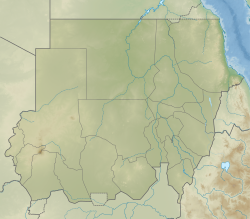 Fortress of Buhen, of the Middle Kingdom, reconstructed under the New Kingdom (about 1200 B.C.) | |
| Location | Northern, Sudan |
|---|---|
| Region | Old Kingdom |
| Coordinates | 21°55′N 31°17′E / 21.917°N 31.283°E |
| Type | Settlement |
Buhen, alternatively known as Βοὥν (Bohón) in Ancient Greek,[1] stands as a significant ancient Egyptian settlement on the western bank of the Nile, just below the Second Cataract in present-day Northern State, Sudan. Its origins trace back to the Old Kingdom period (about 2686–2181BCE), where it served as an Egyptian colonial town, particularly recognized for copper smelting. In 1962, archaeological discoveries brought to light an ancient copper manufacturing facility encircled by an imposing stone barrier, indicating its origin during the rule of Sneferu in the 4th Dynasty. Inscriptions and graffiti disclosed a continuous Egyptian presence spanning two centuries, only to be interrupted by migration from the southern regions in the 5th Dynasty.[2]

